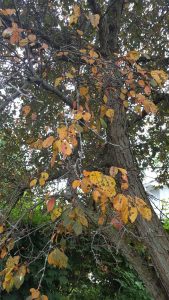
I have a two fold question. First, I have no idea what this tree is so have only been able to perform limited searching. Second, it is sick with something, possibly a fungus? For a couple years now the tree buds and leaves come as normal but sections quickly yellow and blacken and then fall off. What can I do to help this tree? And any idea what it is?
From your photograph we aren’t able to give you a definitive identification of this mature tree. But it is possible to offer some general thoughts on its health. This tree is obviously under stress, and quite possibly from a leaf spot disease.
The first symptoms of leaf spot diseases generally are spots or blotches on foliage. Depending on the plant species, the specific organism, and the stage of the disease, these spots may vary in colour and size, often forming large blotches over time. Leaves often yellow and drop prematurely. Without a definitive identification of the tree, it is not possible to say with certainty exactly what disease this is: there are many fungal leaf spot diseases, but some are also caused by bacteria. Many are host-specific, which means that a specific fungal species or bacterial organism infects only specific plant species. This is why identification is important.
Bacteria will survive by overwintering in infected plants, in leaf debris from these plants, and in some cases in infested soil. Likewise, fungal spores can overwinter in leaf debris around the affected plant. Because of this, good cultural practices for diseased trees are also important: in the fall, and again in spring, clear leaf debris from around the tree and dispose of it in the city’s garden rubbish rather than your own compost; make sure that the tree is well-irrigated (from the root zone, not by watering trunk or leaves) and apply organic material such as compost around the base of the tree (but not mounded up the trunk) to provide additional nutrients to the soil. An otherwise healthy tree is more likely to be able to survive repeated bouts of disease.
You don’t say whether this tree belongs to you, or to a neighbour, or is possibly a city-owned tree. If the latter, you could contact Toronto’s Urban Forestry Department and request a visit by a city arborist. If the tree belongs to you, we would encourage you to contact an arborist who will be able to help with identification of both the tree and the specific pathogen. An arborist can also assist by pruning for better air circulation and removing dead and diseased limbs as needed. Landscape Ontario provides a list of certified arborists, here . The Ontario chapter of the International Society of Arborists also maintains a helpful database, here .

